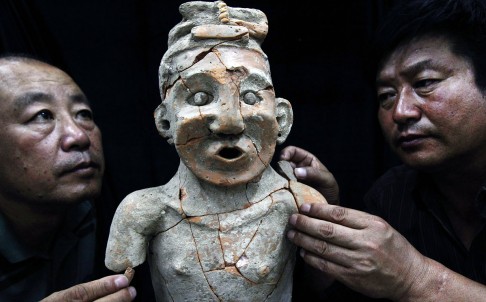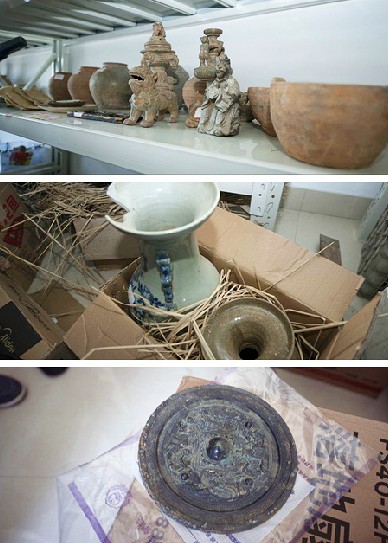Archaeologists repair a terracotta portrait discovered in China's Inner Mongolia Autonomous Region. It is unknown how many artifacts have been stolen by grave robbers. Photo: Xinhua
Police in Shaoxing, Zhejiang province have arrested more than 120 people and seized around 1,300 relics in relation to 144 cases of tomb raiding.
Authorities there described it as the “biggest ever” case of tomb raiding and artefact trafficking in the province’s history.
Shaoxing plays host to hundreds of ancient tombs, some of which are thousands of years old. Archaeologists researching the burial sites first tipped off police to the tomb raiders’ activity, after which a task force was set up to track them down.
More than 800 officers from across Zhejiang took part in the investigation, which eventually resulted in the arrest of 124 people and the recovery of 1,335 cultural relics.
One such relic was a large bronze mirror, dating back to the Jin dynasty over 1,800 years ago.
“There may still be some pieces of national heritage in the relics, identification of them is still ongoing,” an investigator told the Qianjiang Evening News.
The majority of the tomb raiders were from the nearby area, police told reporters.
“They tend to have a good understanding of the history of Shaoxing, they know where to find the tombs,” an officer with the Shaoxing municipal public security bureau told the Evening News.
Police said thieves used the so-called ‘Luoyang shovel’ to find the graves. Invented in 1923 by a grave digger from Luoyang, Henan province, the shovel allows for its user to extract a long section of earth without disturbing the soil structure or digging a large hole. This allows the grave robber to analyse the soil for any bits of pottery, metal or masonry that might indicate an underground tomb.
Grave robbery is endemic across China; posing what experts say is a very real risk that priceless historical artefacts will be lost or stolen. One researcher estimated in 2012 that as many as 100,000 people across the country were involved in the crime.
“We used to say nine out of 10 tombs were empty because of tomb-raiding, but now it has become 9.5 out of 10,” Professor Lei Xingshan, an archaeologist at Peking University, told the Guardian.


No comments:
Post a Comment